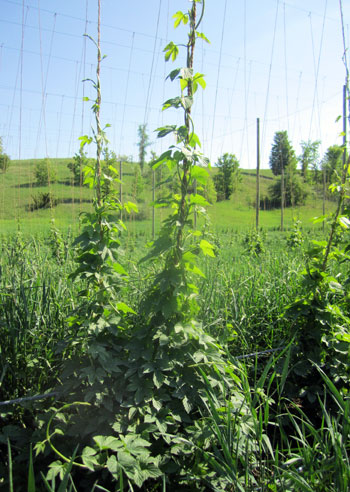By JOSH BENDER
Capital News Service
LANSING — Michigan’s hop industry has exploded into the nation’s fourth-largest, according to a Michigan State University study.
Renewed hop production in the state began in response to a crop shortage elsewhere between 2007 and 2008 and to the growing popularity of Michigan’s craft beer, said Rob Sirrine, a MSU Extension expert.

Credit MSU Extension
Michigan is home to between 60 and 90 commercial hop farms, Sirrine said.
Grand Traverse County grows close to 300 acres of hops, the most in the state, according to a June 2016 survey by MSU. Leelanau County is second, growing close to 150 acres, followed by Barry and Kent counties.
The number of craft breweries in Michigan increased from 105 in 2011 to 205 in 2015, according to the Brewers Association, a national organization. Michigan has the sixth-most craft breweries and produces the 10th-most craft beer of any state.
Michigan has gone from growing roughly 10 acres of hop plants in 2008 to 900 acres in 2016, said Sean Trowbridge, a hop farmer from Atlas Township, near Flint, and secretary of Hop Growers of Michigan.
Sirrine said that while Michigan farmers planted about 900 acres, only about 650 acres will be mature enough to harvest this year.
“Michigan is leading the charge outside the Pacific Northwest,” he said. Washington, Oregon and Idaho combine to grow 90 percent of American hop.
Hop adds bitterness to balance the sweetness of the malt used to make beer and is a natural preservative, said Steve Berthel, head pub brewer at the New Holland Brewery in Holland.
Michigan’s geography and topography help make it a great place for hop farming, Berthel said.
It shares its location between the 42nd and 45th parallel with central Europe, England and the Czech Republic, where hop has grown for centuries.
The state’s sandy soil and long stretches of daylight are also good for hop farming,
And growing it within the state is good for the state’s new breweries.
“Hop from overseas or even in Yakima in Washington state are going to dry out during the shipping process,” Berthel said. “Michigan hops are fresher and that makes for better tasting beer.-
Michigan’s climate and soil separate it from other hop hotbeds further west, he said. “Our beer isn’t going to taste like West Coast IPA because we have our own coast and our own flavor in these hops.”
Trowbridge, of Hop Growers of Michigan, said Chinook hop, a variety grown out west, is noted for the citrusy pine flavor it gives beer, while Michigan Chinook hop adds a bright tinge of pineapple.
Hop is grown throughout the state, but Berthel said that even among varieties grown within Michigan there are differences in flavor depending on location.
That diversity is part of what keeps Michigan brewers using hop from their own state, said Michigan Brewers Guild president Scott Graham. “In time we will see the appeal of those unique characteristics far beyond Michigan.”
Venture capitalists are investing tens of millions of dollars into commercial farms in Michigan, Trowbridge said. Michigan hop farms once ranged from five to 30 acres, now some span hundreds of acres.
The state is poised for growth among larger hop farms but fewer and fewer small and midsized operations will pop up because of start-up costs, he said.
A financially viable farm is at least 10 acres, he said. The costs to a career farmer seeking to start an operation of that size are about $305,000 between converting farmland to grow hop and buying equipment.
While the market is good now, that growth could halt if consumers start to prefer less hoppy beer, he said. Decreased demand would result in a “race to the bottom,” where small and midsized growers won’t be able to lower their prices to compete with larger ones.
Michigan is far from the only hop producer in the Great Lakes Basin.
Ranked right after Michigan at number five is New York, with an estimated 300 acres for harvest in 2016, according to a report from USA Hops, a trade organization. And Wisconsin sits just behind New York with an estimated 297 acres for harvest in 2016.
Together the states and provinces of the Great Lakes Basin will harvest an estimated 1,698 acres of hops in 2016, according to the report. Josh Bender writes for Great Lakes Echo